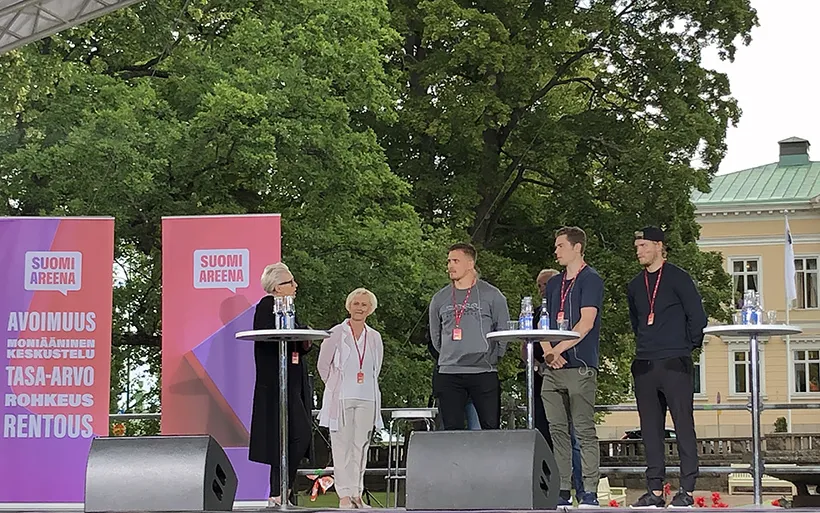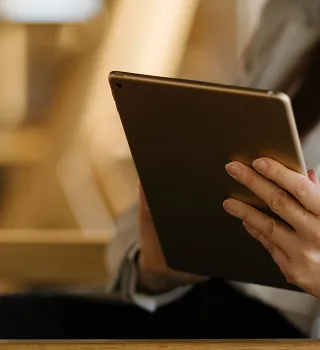How will a Finnish company succeed in export? – 6+ tips from discussions in SuomiAreena

Finland is an export-driven economy, and export should be increased in SMEs, in particular. But what are the methods to ensure successful export and internationalisation? Instead of concentrating on challenges, one should focus on opportunities, do one’s homework well, secure financing and make use of networks that offer assistance in internationalisation. This is the message from the experts in the SuomiAreena discussion organised by Finnvera and Finland Chamber of Commerce themed “The Mölkky skittle-throwing game is taking over the world – what will your company do?”. The participants in the discussion included Tactic Games, the owner of the Mölkky game based in Pori; Konecranes, one of Finland’s largest export companies; and Virpi Horttana, a figure skating coach representing sports.
1. Do the footwork
“Selling and exporting requires a lot of work and footwork,” says Markku Heljakka, chairman of the Board of Directors of Tactic Games, a company that introduced the Mölkky game to the world.
Until 2010, Mölkky was primarily a product sold in the Finnish market. Tactic Games realised that the wooden skittle-throwing game had internationalisation potential and thus took determined measures to export the game. Today, nearly 95 per cent of the Mölkky production is exported.
Titta Mantila, Vice President at Finnvera, also highlights the importance of footwork: A company must have an understanding of the client market or, preferably, already have a customer that is ready to buy. Of course, it is also important to have visibility at trade fairs, but clients can be found by networking and studying the market from home.
“Going abroad to find prospects might not be the thing to do in the beginning and it is perhaps too expensive. Doing your homework is not merely a catch phrase,” Mantila says.
"A company must have an understanding of the client market or, preferably, already have a customer that is ready to buy, says Titta Mantila.
"
2. Focus on customer-orientation
Finns tend to enter the markets with a completed product with strong technical features, while the client may still be looking for a solution for an issue they have. This is the feedback Timo Vuori, Executive Director of Finland Chamber of Commerce, has received from abroad.
“Finns should listen to the client’s needs with a keener ear and create a need, product and service to meet it. The product does not need to be completely ready, since it can be tailored to the conditions,” Vuori says.
According to him, Finns have taken strides forward in sales and marketing, but we still tend to be more on the technocratic side.
“What is lacking is stories created around services and products, which would help the products sell. Sensitivity to cultural differences is also an important skill.
Matti Malminen Director, Trade & Export Finance at Konecranes, a crane and lifting equipment manufacturer with turnover of 3 billion euros and operations in 48 countries, also emphasises customer-centredness and solution orientation and says Finns should not be competing with price abroad.
“Globally, we are known for quality, and we should have the skills to sell just that. We should let our pride in our world-class products and services show. Serenity and reliability are our trump cards.”
3. A story sells
At the initial stages of exporting the Mölkky game, it was suggested to Tactic that the name of the game be changed, since “people don’t even know how to pronounce it.”
“A key thing for us was to stick to what the strength of the product was. Our product is made of birch, which is the national tree of Finland; it comes in a box made of spruce and has a somewhat quirky, no-frills appearance. We did not want to modify it,” Heljakka says.
"How do the French pronounce the name of the game, Mölkky? “Something along the lines of mall-cue,” Markku Heljakka says.
"
The story of Mölkky started to spread beyond the borders of Finland with, for example, tourists and exchange students who saw Finns play Mölkky.
“The word of mouth is a powerful tool when people get excited about a product. It should be boosted, which is exactly what our marketing was based on. We started off in a small area in Normandy, France, where our distribution worked well and we had a committed sales organisation. That is how people learned to play the game, and the game started spreading first in France and then in the neighbouring countries.
On the other hand, a quality product itself is the best marketing tool,” Heljakka says.
By the way, how do the French pronounce the name of the game, Mölkky? “Something along the lines of mall-cue,” Heljakka says.
4. Financing is often key
Sometimes financing plays a decisive role in making export happen and in closing deals. Matti Malminen, representing a large corporate, says that there are plenty of providers of financing, but in the SME and start-up sector, financing may be a real challenge at the initial stages of export when working capital and product development are needed. On the other hand, large exporters have their own challenges regarding financing:
“The international clients of companies like us that sell large machinery need financing. They want long payment terms of 7–10 years for large projects, which results in us exporters needing providers of financing who will bear the risk of a foreign buyer. That is when Finnvera, among others, comes along to support Finnish export and employment,” Malminen says and praises Finnvera’s positive attitude towards financing large export projects.
For an individual export project to be financed, a balance between the plan and the available resources is essential.
“By resources I mean money, financing, production and manufacture. If the company’s stakes in a project are high and there is no safety margin, the project will not tolerate any kind of failure or mishap,” Finnvera’s Titta Mantila says.
Matti Malminen points out that an enlightened exporter should protect their company against the risk of the buyer not paying the bill.
“The magic words are ‘Know your customer’. That will help you get a feel of the buyer and whether the buyer company will actually pay the bill at some point.”
5. Purchasing habits in turmoil due to digitalisation
Digitalisation also came up in the discussion about distribution and purchasing, among other things. Finding the correct distribution channel may be a central challenge and a risk that needs to be managed. According to Markku Heljakka, Tactics products, for example, are sold almost completely through intermediaries, such as retailers or online stores.
“These days, in particular, online stores kill bricks-and-mortar at a fast pace, and that is a challenge. We must be able to prepare for it somehow. There have been huge changes in the purchasing habits of consumers.”
6. Companies should make use of networks
One should not ignore cooperation and networks, contacts and tacit knowledge. A company does not need to try to export its products all alone, Timo Vuori of Finland Chamber of Commerce stresses.
“In Finland, there are excellent public services related to internationalisation, such as Business Finland, Finnvera, and others. Cooperation also works well with private players, such as the export financing tour organised by Finnvera, banks and credit insurers. This tour has enabled us to train 500 companies to obtain and manage export financing. Every country has a chamber of commerce with an interest to help companies with trade. After consulting the aforementioned services, the company is in charge of taking the next steps in export,” Vuori says.
"In Finland, there are excellent public services related to internationalisation, such as Business Finland, Finnvera, and others. Cooperation also works well with private players, says Timo Vuori.
"
6+. What can a business learn from sports?
The sports culture. That is the term used by Virpi Horttana, who coaches Finnish figure skaters. The sports culture is clearly connected to the internationalisation and potential success of companies.
“If a country’s sports culture in a certain sport is strong, that country most likely possesses the best knowhow, financial resources and conditions, ability and experience to reach the top,” Horttana says.
In addition, both an athlete and a company must be prepared to tolerate setbacks:
“You have to be hungry for becoming good enough to get to the next level. Being too satisfied with where you are will halt your development.”
***
